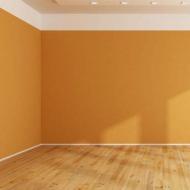
Country building. Country buildings. Ideas for small cozy country houses
Most residents of cities and megacities have a summer cottage - a calm atmosphere and proximity to nature make it a desirable place to relax during weekends or holidays. However, before you can spend time at your country residence, the site needs to be landscaped. Without a roof over your head and a minimum of amenities, resting on bare ground will be a dubious enough pleasure.
If you decide to quickly prepare a summer cottage for the holiday season, while spending a minimum of financial and physical resources, then temporary lightweight buildings will be ideal for you. In this article, you will be provided with step-by-step instructions on how to build a country house and outbuildings in the country with your own hands.
Summer cottage construction
As mentioned above, the construction of a country house is best carried out according to a simplified scheme in order to facilitate construction work as much as possible. Below we will consider the main stages of the construction of a building with a lightweight structure.
Foundation preparation

Do-it-yourself buildings for summer cottages, it is best to build on a shallowly buried one. The light weight of the structure makes it possible not to go deep into the ground, thereby significantly reducing the consumption of concrete.
The order of work is as follows:
- First of all, the perimeter is marked. According to the marks made, trenches are dug at least half a meter deep and up to 40 cm wide. Half of the trench is covered with fine gravel to form a pillow;
- Formwork is exposed - its height depends on the dimensions of the future foundation. In most cases, 30 cm for the ground part of the foundation is quite enough. The formwork must be spread out with side stops and wedges so that the concrete mass does not squeeze it out;

- A metal frame is laid in the trench, which is welded from four parallel fittings. When assembling and laying reinforcement, it should be borne in mind that it should be located exactly in the middle of the future foundation;
- Preparing a concrete mixture of cement, sand and gravel in a ratio of 1:2:3. When pouring, you can throw small stones into the formwork, which will reduce the consumption of the mixture.
Walling
After the foundation has completely dried, you can begin to build walls. The construction of a country house with their own hands is most often carried out from lightweight materials - foam concrete, polystyrene concrete or expanded clay concrete blocks, which have a relatively small mass and good thermal insulation properties.

As a mixture for laying blocks, you can use both a special masonry adhesive and a home-made cement composition. In the first case, a thin seam is formed, but the price of this product is not always acceptable. The cement mixture, at a lower cost, creates a thicker joint, since its structure is less plastic.
The laying of blocks is carried out according to the following principle:
- First of all, a masonry mortar is formed. If we are talking about a ready-made dry mix, then just add water to it and mix thoroughly. Homemade mortar is prepared from sand and cement, which are mixed in a ratio of 1: 3. As a liquid, milk of lime is added to it, which plays the role of a modifying additive;
Note!
When preparing a home-made mortar for masonry, sand must be sifted through a fine mesh to remove stones, otherwise building a country house with your own hands can become very complicated.
- Before starting masonry, it is necessary to lay a layer of waterproofing on the foundation so that moisture from the soil does not rise to the wall. For this purpose, any moisture-resistant material is suitable - roofing material, thick polyethylene, etc.;

- The first row of the block is laid out around the perimeter, then, using a plumb line or level, vertically even corners are laid in several rows. A thread is stretched between the corners, along which intermediate blocks are laid out - thus, you will get a perfectly even masonry. When laying out the block, do not forget to follow the step and form a bundle between the rows;
Note!
In one day, no more than five rows of masonry can be laid out, since, with a larger number, there is a risk of collapse.
- To form window or door openings, lintels are placed, which can be made of wood, metal or concrete at your discretion. The main thing is that they withstand the weight of the masonry and the future roof. It should be borne in mind that one of the sides of the building should be several rows higher than the other to create a slope for the future roof.
Roof decking

The formation of the roof begins with the laying of the supporting beams for the ceiling, which are spaced at intervals of one meter. After laying the carriers, a black ceiling is formed - boards or plywood are stuffed, on which insulation is covered or poured. Boards are laid around the entire perimeter of the building, which will serve as a mount for the rafters.
Rafters are installed with a step of no more than one meter. Then the transverse strips are mounted, which will serve as the basis for the roof - the gap between them is determined based on the type of material. After that, you can proceed to the flooring of slate, ondulin, tin, etc. (See also article
Since you are reading this article, a vacation outside the city on your site is attractive to you. A country house for this, of course, is necessary. It is highly desirable to build it simple, cheap and. For the sake of saving not only money and their labor, but also land. In this publication you will find information on how to build a country house with your own hands, perhaps easier, faster, easier and cheaper. It is also desirable that the ergonomics of the house allows you to wait out a long bad weather in it without experiencing discomfort, and the design of the building makes it possible to use various design solutions for its external and internal design.

Where to start
The first question that needs to be solved when planning to build a country house is what to build it from? Where - it is already known, the site will not be moved anywhere. According to the material, soil at the construction site and weather conditions, the design of the house is selected, a ready-made project is developed or selected for it, and then - estimates, purchases, and for business. We will start with the choice of material.
What to build from?
Since we are interested in options that are easy to implement, log houses are also excluded from consideration: it is very difficult to build them on your own. In addition, such houses are sensitive to seasonal ground movements and therefore require a foundation no less reliable than a fully buried tape one (from 0.6 m below the standard freezing depth of the NGP, counting along the bottom of the tape). The foundation of full penetration must stand to give its own shrinkage, at least from the end of summer until full spring warmth next year. The same endurance is required for insulated slab foundations, for example. swedish plate. True, there is a type of foundation for wooden houses that does not require a technological break (see below), but the timber or log structure itself must shrink for a year before it is ready for finishing. So a log or log house will be disproportionately expensive (from approx. 12,000 rubles / sq. m) and difficult to build on your own.
The same situation arises with brick houses and. Ultimately, the construction of a small country house made of brick, foam block or timber turns out to be appropriate only in very small areas, when an extremely compact structure is required. In this case, the house is built 2-storey; brick and lumber technologies allow an unprepared, but attentive and accurate builder to build a house on 2 floors. Examples of the layout of compact 2-storey brick and timber houses are shown in Fig.:

Note: it is easier for a novice builder to build a foam block house than a brick, timber or log house. The construction of a country house from foam / gas blocks makes sense if the cottage is visited all year round - no additional insulation is needed and there will be less heating costs.
The easiest and fastest way to build a small house is to assemble it from a prefabricated panel house kit or structurally insulated panels (SIP). A 20x20-foot (6x6 m) prefabricated house is set up in a week by a pair of chimpanzees of average mental ability trained according to the instructions for the kit. No joke, there were such experiences. But, alas, the cost of construction. At current prices, somewhere from 18,000 rubles / sq. m. Without foundation.
A SIP house will cost less, approx. from 15,000 rubles/sq. m with a foundation on geoscrews (see below). However, SIP structures are held on locks between the panels. In order for a SIP house to be completely reliable, it must have a lot of internal partitions from the same SIP with locks. Since there are few or no partitions in a compact house, we also do not touch SIP as a material for it.
So we come to the conclusion: to build a country house, so that it is fast, simple and inexpensive, you need it from wood. With one small but very significant exception, see below.
Project
An inexpensive garden and / or compact country house is best built according to a standard project; see below for essential construction details. A ready-made free project of a country house is quite easy to find using any search engine. Or for a fee - a detailed standard project of a garden house for 300 rubles. find really on the relevant sites.
How to choose easier and cheaper
However, when sorting through projects, it is necessary to take into account some significant circumstances, namely, the cost, duration and complexity of the zero cycle, i.e. earthworks and laying the foundation. It's the frosty heaving of the soil. With seasonal shifts, the ground under the house does not shake and does not roll over in waves. Summer cottages are cut into soils of various kinds, but having one common property - sufficient connectivity of their own, otherwise no one needs such a summer cottage. Therefore, within a certain space on the surface, frost heaving of the soil is reduced mainly to raising/reverse subsidence of its surface with a slight heel.On the other hand, a small country house has excessive rigidity and elasticity. Here the square-cube law, well known to technology (and stubbornly overlooked by amateurs), operates here. It is easy to test it by experience: glue cubes with sides of 2 and 10 cm from ordinary writing paper and try to crumple one and the other. The third factor is the intrinsic cohesion of the soil is inextricably linked with its mechanical properties.
Without going into further details, we will immediately report the conclusion: if a small wooden country house in terms of fit into a circle of a certain diameter, then on ordinary soils of garden plots it can be built on an unburied foundation, which is much faster, easier and cheaper. In what circle should the project of a wooden house fit in the plan so that it can be built on an unburied foundation on soils up to and including medium-heavy, is shown in fig. It all depends, as we see, on the proportions of the structure: the more square the house, the better it plays out seasonal ground movements. Therefore, it is better to build “tramway” houses for narrow sections, without looking closely, on the foundation of a normal depth. But if the ratio of the “sticks” of a T-shaped house lies within 1 Note: the veranda/terrace is included in the projection of the house if it is rigidly connected with its design. Verandas that do not have a mechanical connection with the house or are hinged to it are excluded from the projection of the house in the plan. We will assume that we have decided on the foundation. We only recall that under a brick, timber or log house on all soils, except for non-rocky ones, it is necessary to lay a normally buried tape or TISE foundation. The slab foundation with insulation “settles down” on the ground for 2-3 years; this is enough for a timber or log house to begin to split. Under a house made of timber or foam blocks on slightly heaving soil, it is possible to lay a foundation on geo-screws (see below) with a steel grillage. An unburied foundation for a compact country house is the easiest and cheapest way to assemble a columnar foundation from ready-made concrete blocks 200x200x400. Blocks are laid out on a cement-sand mortar from M150, two in a row; top across the bottom. Thus, the column is obtained in terms of 400x400 mm. Pit pits for posts are dug to a depth of 0.5 m; of which 15 + 15 cm falls on the anti-rock sand and gravel pillow. It makes no sense to deepen the columns of blocks by more than 20 cm: the dressing of the seams is weak, and the horizontal components of the frost heaving forces will tear the columns. The number of rows of blocks in the column is made more than 2 if the house needs to be raised above the ground by more than 20 cm. a week. The recessed foundation of a compact house is often, following the model of large buildings, piled on bored piles in soft roofing material formwork. If the house is on a slope, asbestos-cement pipes are taken to the pile shell, which makes it possible to compensate for the height difference along the slope of up to 1.7 m or more. With regard to fast small-sized construction, the disadvantage of these foundations is the same as that of the tape - it must stand and settle at least from autumn to spring. Note: there is no point in laying the TISE foundation for a light compact house - the "caps" of the TISE piles normally work in the ground only under a sufficient weight load from the building. Of the small-sized houses, only a 2-story brick or concrete one is capable of creating one. The best option for a recessed foundation for a compact house is on geoscrews. Geo-screws are a type of shortened screw piles especially for light buildings. Unlike conventional ones, ground screws are not designed for swampy, loose and floating soils. A foundation with geoscrews for a large house will cost significantly more than a self-made tape foundation, because. ground screws are not cheap in themselves, but for a small house this is not so scary, since few screws are required. A geo-screw for soils of low and medium density, according to the principle of keeping it in the ground, is somewhat similar to a furniture confirmation screw and also looks like it, see Fig.: The smooth head of geoscrews for dense soils is uniformly cylindrical. Those and other ground screws can be used on soils up to excessively heaving. On the heads of geoscrews, you can either lay the wooden lower trim of the structure, or mount a steel grillage. For information on how a wooden house is built on screw piles, see, for example. track. video: The advantages of ground screws for quick construction on a small site in cramped conditions are enormous: Note: if you are building according to a ready-made project, which indicates the type and characteristics of the foundation, then you need to follow the recommendations of the designers, or consult with them about whether such a foundation is suitable on such and such soil. We come to the very essence: what kind of simple country house will be built cheaper and most likely? In ascending order of cost, complexity and time of construction, as well as potentially aesthetic qualities (suitability for design and decoration), the options are next. way: KUNG is an abbreviation for a Unified Body of Normal (Zero) Size. In the USSR, unified closed bodies for cars appeared after the Second World War and, thanks to their convenience, the name kung soon became a household name. A country house made of kung, most importantly, is very cheap: a decommissioned kung change house from ZIL-131 can be found for 30,000 rubles. And the construction comes down to bringing it and putting it on posts, concrete supports of grape trellises, etc., laid on a crushed stone pillow (so that weeds do not germinate and annoying living creatures do not start). The foundation for the kung is not needed on any ground in any climate - the kung is designed for off-road driving and overturning of the carrier vehicle. The kung has only one drawback as a country house: a utilitarian appearance, which any designer's attempts only stick out. But there are a lot of advantages: It is better to look for a kung for a country house from ZIL-131 or GAZ-66 cars (see fig.): they have a flat floor and it is easier to put them on posts due to small or no recesses for wheel niches. You need 6 columns (it can be brick folded dry): in the corners in the middle of the long sides. Among other things, kungs from ZIL-131 and GAZ-66 are cheaper and easier to convert into housing than Ural and KAMAZ ones. Note: do not take non-standardized "booths" from the ancient ZiS's and GAZ-51-53, their frames are highly susceptible to corrosion and insulation is no good. The width of the kung is standard according to the zero auto-dimension (2.4 m), and the length can be in the range of 3.5-8.5 m. laying a deep foundation. For a country house, it is preferable to look for a two-slot kung (two-slot), on the left in fig. But any other empty one turns out to be surprisingly spacious, in the center. Kung change houses (top left and right in the figure) already provide normal habitability for 3-4 people, but it would be even better to look for a kung from old hardware communications. There are also sleeping places for a crew of 3-4 people, and after some application of your hands from such a kung, you get not a house, but a candy, at the bottom right in fig. It is better to remove the right (looking from the entrance inside) compartment for the autonomous power supply (BEA) gas unit: a mini-toilet with a shower is placed in its place. Removing half of the shelves above the left compartment of the BEA, we get a place for a gas stove for 1-2 burners and a small cutting table. The BEA compartment itself, as if on purpose, is intended for garden tools, planting material, etc., and with access also from the outside, through a wide hatch. In addition, there are side windows in the hardware communications kungs, which can not be said about all kungs - military cabins. Chalet means hut, and what changes the meaning of this word has undergone with the development of architecture is another matter. A country house-hut is durable almost the same as a kung, because. its load-bearing trusses are triangular. A small house-hut (approx. up to 4x6 m) can be placed on a non-buried foundation on any soil, except for excessively heaving. Materials for a hut house are required 1.5-2 times less than for a bungalow or frame house, and it is easier to build it without experience and with a minimum set of tools. The hut house has one more advantage inherited from the ancestors: it fits perfectly with almost any finish in any landscape, see fig.: There are few drawbacks to the chalet. The house-hut retains all its advantages up to a size in terms of approx. 6x9 m, then it becomes more complex and material-intensive than traditional ones. Even in a small-sized hut, one of the sleeping places has to be equipped in the attic, where you have to climb a vertical ladder, that's all. In America and Canada, single hut houses are quite widespread - shelters for hunters, fishermen, beekeepers, seasonal sharecroppers (this is the same as the Soviet hectare farmer, who remembers), on the left and in the center in the figure: Arrangement of a single-seat house-hut - a shelter and a 3-seat country house But a house-hut of only 3x3 m in plan can also be a country house for 2-3 people, on the right. In both cases, there are few heating costs, because. the relative area of heat loss of a house-hut is smaller and it warms up faster due to more active air circulation. If your dacha is commercially inhabited from the first spring heat to the winter cold, then the hut house is optimal for you. After the kung, if you manage to buy it, who knows, they know the real price of the kung. The construction of a hut house with dimensions in terms of up to 6x4 m is carried out step by step. way (this is the so-called airship technology developed by the Germans to build their zeppelins): The hut house will be strong enough and durable only if the work on its construction is carried out in the specified sequence. This is probably the reason why few build hut houses - it’s easier to work on the principle of “take more, throw more”. Drawings of a house-hut 3x3 m for two or three are given in Fig.: The inset at the top left shows the design of facade frames for a house up to 4x6 m. The material, as well as intermediate frames, is timber 150x75. Firstly, on the facade frames, 2 ties are added to the tightening (intermediate frames without them). Secondly, instead of a ridge run, a ridge beam of the same section is used. Thirdly, the frames, except at the corners, are fastened with middle and upper straps (longitudinal stiffeners) from the same beam. Longitudinal and transverse bonds are connected by a half-tree tie-in. Those. using the example of a 4x6 m house, it is already clear how the complexity of construction and the material consumption of a hut house grow with an increase in its size. Note: on the lower screed, 2 more ends of the beam 100x75 are visible on the sides of the window. They are supported by internal partitions. The door frame on the other façade extends up to tightening and is made of timber 75x150; the lower screed of this facade is split. If this house is without a base, the window frame is similarly performed. In the general concept of a bungalow, this is an unheated one-room country house with an extensive covered veranda, structurally integral to it. For a weekend summer cottage in fairly warm regions, a “generally accepted” bungalow house is optimal, because. it is spacious, well ventilated, does not overheat by the Sun, and in construction it is no more complicated than a frame house, but less material-intensive. However, today little is known to professional builders outside the tropics that the bungalow is also a kind of building technology. Bungalow huts built on it (another name is hakale) can still be found in the wilds of Russia, the north of the USA and all of Canada. Some of them are over 200 years old, but most of them are still habitable. A house built using bungalow technology is easily recognizable by its 2-layer sheathing of vertical boards; the outer row is intermittent, see fig. on right. Bungalow, as a technology of wooden construction, combines elements of half-timbered structures and frame with working sheathing. Compared to both, bungalow technology has a footprint. advantages: The disadvantages of building using bungalow technology are, firstly, the increased requirements for the experience and accuracy of the worker (see below). Secondly, there is some complexity in the design of openings: the outer skin boards need to be cut in place to fit the trim, otherwise pockets are formed - moisture traps. Bungalows as shelters are generally more popular than huts due to better habitability. In a bungalow, you do not have to climb up to sleep and stick out to eat. The device of a bungalow-type shelter is shown in the figure: Drawings of a mini bungalow house - shelters The foundation, of course, is not necessarily a strip foundation (in this case, an unburied strip foundation, NZLF), but any one suitable for local conditions. If columnar or pile, then 12 supports are needed: 3 on the sides along the veranda and 4 (under each vertical rack) on the others. This house can be extended in length up to 3-3.5 m. Then, if you do not lengthen acc. veranda, you can fence off the toilet, and the attic in any case remains free for property and supplies. The “real” bungalow for outdoor recreation with dimensions of 4x5.875 m is, of course, more complicated in plan (see the next figure), just like a frame house (see below). There is no attic (this is a characteristic feature of "real" recreational bungalows). The requirements for the foundation are the same, but already for soils up to and including medium heaving; prev. the option is excellent also on strongly heaving soils. The main features of the bungalow as a building technology are indicated above. In addition: the power frame is assembled from a bar from 150x150 without jibs. Yes Yes! The rigidity of the structure is given by the sheathing of vertical boards. Plywood and OSB are of little use, because under each joint of sheets, lining racks and valleys are needed. Bungalow construction schemes are given in the figure: The truss floor structures are not conventionally shown, they are ordinary. Please note, on the left in the figure: the triple corners of the frame are assembled in a half-tree and into a spike, and the spikes of the racks are on the inside of the corners. This is an indispensable condition for the strength of the structure: the elements of the load-bearing frame must cling to each other at the corners even without steel fasteners. Although it is necessary, see the scheme for reinforcing the corners in the center in fig. It is unacceptable to use steel corners, linings, etc. in this case! For the Old Testament "oakness" you have to pay with labor. Sheathing boards need to be oriented with “humps” (bulges of annual layers) as shown on the right in the figure: inner inside, outer out. The outer boards should be slightly narrower than the inner ones, then in the process of warping the wood, the sheathing will compact and compress the frame. With any other arrangement of "humpbacks" it will split and the whole house will weaken. All boards are attached to the frame along short (end) edges with three (not in pairs!) Nails or self-tapping screws. The edge boards are also fastened along the long edges to the corner posts with the same fasteners in a row or with a snake (zigzag) in increments of 100-120 mm. The outer boards are attached to the inner boards along short edges with pairs of fasteners; long - in a row with the same step. The assembly of the power frame of the bungalow is a very important stage of work. And laborious, because you can’t hammer staples with a carpenter’s hammer, and you can’t tighten 12x300 self-tapping screws with a screwdriver. In old designs, instead of self-tapping screws, oak dowels were placed in wedging. The frame of the house using bungalow technology is assembled in the next. order: The frame mini-house does not have any features compared to the large residential one; the scheme of its device is given in Fig.: The order of construction is described in detail and with illustrations in many sources. You can also watch a video about the construction of a "classic" frame house 6x4 m:
The complexity and cost of building a frame house is higher than all those described above. The attention, knowledge and accuracy required to build a hut house and a bungalow do not count: they do not require costs and do not take time. But the frame mini-house also has an undeniable advantage: a simple shape with vertical walls and smooth cladding make it suitable for a wide variety of design delights, see fig. Also, the design of the frame house is very plastic. On the one hand, it forgives rather gross mistakes of novice builders. On the other hand, it gives creative lovers a certain scope for experimentation. See, for example, a video about the construction of a small frame house-shelter:
It is only necessary to add to this plot that the comments of the audience about the insulation are fair. Since it is impossible to “drive out” the dew point once and for all outside, and there are no massive walls where it could “walk”, insulating materials in such structures must be used to prevent condensation in the insulation layer and further inside: EPPS or cellulose insulation (ecowool) . The crossbar of the roof (all as it is, its supporting structure) of a small house also has a feature. It is determined by its small size, and, as a result, the excessive rigidity of the structure, as well as the absence in it (forgive the clericalism), put a load-bearing partition (internal main wall). To hold the latter, a fully connected foundation is needed; at least - tape normal depth. Rafter structures (in this case, this is the same roof beam) are, as you know, hanging (pos. 1a in the figure) and layered (pos. 1b): In the first, the rack of the truss truss rests on a transverse screed beam, and in a layered truss, on a load-bearing partition; split tie. It is technically possible to make a load-bearing partition in a small house, but it is not justified in any sense, including ergonomic - habitability. Therefore, the roof trusses of small houses are made only hanging. As for the methods of assembling the truss structure of a small house, they can be any of the well-known poses. 3 and 4. Choose whatever you like according to skill, availability of materials and desire. The minimum size of boards for a house up to 6x6 m is 40x130, ridge timber - 100x75 and Mauerlat - from 150x75. In a bungalow house and a frame Mauerlat, a beam of the upper trim can directly serve. When choosing a garage project, future owners may have doubts or questions about which design to choose: a house with a garage or a separate garage. Let's take a look at the list of potential advantages and disadvantages of these two solutions and take a closer look at garage projects with an attic. Benefits of a home with…
27.06.2017
A bonfire in the country is a special pleasure that is not available to us in a city apartment. Having made an outdoor hearth with your own hands, you can enjoy the play of fire more often, cook something tasty on the grate by the hearth, or just soak up the warmth on cold evenings. For the fire...
15.05.2017
How to equip an economy version of a summer kitchen near the house? For example, your summer kitchen can be placed on a ready-made terrace, as in these photos. Or, by considering this summer kitchen project, you will discover hidden reserves for building a simple summer kitchen and on your ...
30.04.2017
In the warm season, we spend more and more time outside. A simple summer kitchen with our own hands will allow us to transfer both family dinners and friendly gatherings to the street. Despite the fact that there are technically complex summer kitchen options, we will consider ...
02.04.2017
An excellent do-it-yourself gazebo can be built inexpensively from old windows. We will show, using the example of this beautiful cottage, the stages of building a gazebo and its arrangement. Do-it-yourself gazebo: an inexpensive option from used windows. We select the dimensions of the gazebo in accordance with the dimensions of our ...
28.03.2017
A do-it-yourself gazebo with a barbecue is able to satisfy every taste - it doesn’t matter what material it is made of and what project it is made of, such a gazebo will always be the center of attraction in the country. Tempting dishes on the grill will please not only you, but …
26.03.2017
For those who love outdoor food, we offer an interesting project on how to make a brick outdoor grill with your own hands. Just imagine how many tempting kebabs and other delicious dishes you have to cook in the country for yourself and your friends. Here …
01.11.2016
A gazebo with barbecue turns the usual process of cooking in your kitchen into the culinary magic of cooking food on an open fire. Few dishes on our menu are as genuinely loved as kebabs cooked on the grill. Let's see how to get more... What to do in the country, in addition to the cultivation of crops? Of course, invite friends and family to sit in the gazebo, admire the small makeshift pond, freshen up under the summer shower and taste fragrant dishes prepared on the grill built by oneself. The outbuildings are varied. They make your stay more comfortable and enjoyable. And following detailed step-by-step instructions, you can independently build any structure on the site. Arbors for giving can be mobile (collapsible) and stationary. Closed (glazed) and open. Inside, you can arrange comfortable benches, a table, a barbecue, flower pots and other nice additions in the form of soft lighting or draperies. Consider the stages of construction of the most popular stationary open gazebo made of wood. This design is quickly erected, looks great among flowering trees and shrubs, and construction costs are minimal. If you plan to relax in a secluded gazebo, then install it in a secluded corner of the site. And if the gazebo becomes a decoration of the site and a dining place, then it is better to choose a location not far from the house. In any case, the gazebo should be located within walking distance, on a flat area, from where it is first recommended to remove grass and large cobblestones. Since the gazebo is a fairly light structure, then the foundation should be equipped with a simplified one, for example, tape or pile. Monolithic foundations are mainly poured under closed-type brick gazebos with a barbecue. Step 1. Work usually begins with the layout of the site. Pegs are driven into the ground, between which a cable is pulled. It is obligatory to check the alignment and carefully reconcile the distance between the stakes. Step 2 Consider the option of building a columnar base for the gazebo. After marking, earthworks are carried out, namely, square-section pits are dug, 15-20 cm deep. For moving soils, the depth of the pits will be up to 60 cm. The bottom of each pit is carefully rammed and covered with a layer of sand (about 5 cm). Sand spills with water. Reinforcement bars are driven into the center of each pit and aligned with a plumb line. Step 3 Bricks are laid around the bars. The resulting columns must be checked for verticality and horizontality using a water or long bubble level. In case of deviations from the horizontal, a layer of cement mortar is placed on the brick columns. Step 4. In order for the gazebo to stand for a long time, all columns are smeared with bitumen and covered with pieces of roofing material. You can start building the frame in 3-4 days. This period is necessary so that the cement has time to harden. We construct the lower harness, connecting 4 beams using the “half-tree” method. We fasten the harness to the poles and erect vertical supports, which we fix using metal corners and self-tapping screws. We strengthen the vertical beams with horizontal bars around the perimeter, not forgetting the entrance to the gazebo. We begin to assemble the upper harness from the bars, also fixing them with corners and self-tapping screws. In the process of work, it is important to constantly monitor the verticality and horizontality of the installation of all elements so that the structure does not tilt. It is equally important to treat the wood with fire-retardant impregnation before installation. Before installing the roof, it is worth arranging the floor and wall cladding. We lay logs for the floor, sawing the bars along the length of the gazebo. We lay boards across the lag. The recommended thickness of floorboards is 40-60 mm. We nail the boards to the logs with nails 120-150 mm long. The roof of the gazebo can be made of metal profiles, soft roofing (for example, euroslate), plastic (for example, cellular polycarbonate). Rarely, reeds and straw are used as roofing. At the same time, the configuration of the roof can be very diverse - from a shed structure to a complex tent. How to make a roof for a gazebo is described in detail in the video tutorial.
One of the useful country buildings is a summer shower. Among the advantages - the ability to freshen up on a hot summer day and wash off the dust after working in the garden. There is only one drawback - the simplest design of an outdoor country shower does not allow you to perform hygiene procedures in cool and windy weather. To make a shower, you need a tank with a lid and a faucet. We paint the walls of this container inside and out with black paint. So the water will quickly heat up in the sun. We attach a sufficiently long hose to the tap, on the free end of which we fasten the shower head. If one of the walls of a country house becomes such a place, then we will definitely veneer it with ceramic tiles. Otherwise, exposure to moisture will adversely affect the condition of the structure. If the shower is installed in an open area, then for convenience we equip a pallet, for example, made of plastic, and we install the tank on four metal supports driven into the ground. This design can be supplemented with a light nylon curtain, covered with an opaque polyethylene film or monolithic polycarbonate. If such a shower will be used frequently, especially by a family of two or more people, then care must be taken to dispose of wastewater. A more “advanced” version of a summer shower is a house with a washing room, a dressing room and a simple solid fuel boiler with a pump installed inside. For such a house, four supporting pillars made of bricks and a light frame made of beams are enough. You can sheathe the walls with wood boards, and decorate the outside with any finishing coating. Interior decoration should be chosen moisture resistant, for example, ceramic tiles or plastic panels. Such a country shower can be taken both in a cool autumn and in a hot summer, simply by melting the boiler. For climbing plants, such as roses or grapes, you can build an arch from wooden elements. The design is not complex, its elements are affordable. The arch will become an unusual decoration of the site. The dimensions of the arch depend on the type of plants chosen for landscaping. For example, if the structure is wide, then in the summer a garden bench can be placed under it. But with a lack of free space on the site, it is better to stop at a smaller structure. In any case, it is important that it is strong and reliable. We will make a small arch - 180 cm high and 150 cm wide, 250 cm long. Step 1. We cut the beam for the frame into segments 2.2 meters long. You need 6 posts for vertical racks and 4 elements for the top trim. The length of the vertical posts should be 40 cm longer than the planned height of the structure. We cover the tree with impregnation, which will protect against mold and pests. Step 2. We proceed to strengthen the frame on the ground. We choose a place, mark out the dimensions of the arch (length 250 cm, width - 150 cm). On the ground we make markings for the location of the arch. To make the structure strong and reliable, we build a kind of point foundation from buckets dug into the ground. We dig in the first pair of buckets at the beginning of the arch at a distance of 150 cm. The second - after 120 cm, the third - after 250 cm relative to the first pair. Then we dilute the cement and pour it into containers. Until the mixture has hardened, we immerse vertical poles in buckets and fix them with homemade struts. Step 3. After the cement hardens, we proceed to fix the upper trim of the structure. We attach two beams 250 cm long and two beams 150 cm long to vertical posts using corners and self-tapping screws. The frame is ready. Step 4. We construct a crate that will serve as additional stiffeners and serve as support for climbing plants. We cut the beams with a smaller section to the desired size and screw them onto the screws to the walls of the arch and the ceiling. The step between the elements is 30-40 cm. A simple plant support structure is ready. All wooden elements need to be painted. In a few years, when grapes or roses grow and completely cover the walls and ceiling of the structure, the arch will turn out to be a place where it will be pleasant to relax on a hot summer day. Having got out of the stuffy tightness of a city apartment, a novice summer resident seeks to turn his land allotment into a cozy corner. A pleasant confusion reigns in his head from the variety of plans. Hands are ready to move mountains, and the next vacation is already scheduled in advance by hours and minutes. However, despite the constant time trouble, one should not rush into arranging the dacha. A well-thought-out plan must underlie future transformations. It is necessary to indicate the location of each building in it, while not forgetting to check with the existing norms and rules for building summer cottages. When deciding what to build on a summer cottage, we will follow the Russian proverb that says that "you need to dance from the stove." In the appendix to the land plot, such a “stove” is a residential building. He is given the main place in the future master plan. All distances between buildings in the country are clear, based on common sense. Having read them in detail and thoughtfully, you will protect yourself from serious mistakes and border problems with your neighbors. Obviously, there should be some kind of “sanitary zone” (10-15 measures) between the outbuildings and the house, which will save you from noise, dust and odors. In addition, placing a recreation area (gazebos, barbecue area or pond) next to the poultry house cannot be called a rational solution either. With proper zoning on a standard 6 acres, you can place all the necessary facilities without feeling crowded. Do not forget that according to current regulations, the total area of dacha development should not exceed 30% of the total area of \u200b\u200bthe site. In addition to durability and comfort, all buildings in the country should meet the canons of aesthetics and organically fit into the landscape. Therefore, it is not recommended to build them from different materials. For example, if your house is built of brick or timber, then it is better to build a bathhouse from the same materials. If the roof of the dwelling is made of metal tiles, then it would not be very appropriate to cover the bathhouse with straw or reeds. “Live yourself and do not interfere with others” - this important principle should be taken into account when planning the improvement of the dacha. Therefore, add to your plan in advance between buildings, and do not block your neighbors with fences that are impenetrable to sunlight. After the country house, the second most important object is the utility block. This is a multifunctional building that can accommodate a poultry house and a workshop, a pantry, a toilet, a shower and a woodshed. It is irrational to combine a utility block and a garage, since it is better to park a car closer to home, and it is more profitable to build utility rooms away from housing. If you are not friends with the tool and do not understand construction, you can purchase a ready-made container hozblok. It contains a minimum set of premises for the daily needs of a summer resident. If assembling a wooden frame is not a problem for you, then you will master it in one week. After installing the supporting frame, wall cladding with siding or board, it remains to insulate the building (ecowool or mineral wool). You can build a hozblok of brick or foam concrete. It will be more durable than wood, but it will take more time and effort to build. Very often, the competent location of buildings on the site requires not only strict adherence to norms, but also rational thinking. For example, some summer residents build a hozblok so that it has a well inside. So they protect the surface pump from freezing and at the same time block children's access to an open source of water. We should not forget that outbuildings are an ideal place for placing engineering equipment. Here it is securely hidden from theft and does not disturb with its noise. In addition to outbuildings, the placement of buildings on the land involves the construction of gazebos, baths, greenhouses, barbecue and playgrounds. There are dozens of design options for this structure. Only the basic requirements for a country bath remain unchanged: a well-insulated floor, walls and ceiling, effective ventilation and maximum protection of structures from moisture. The construction of a bath should not be taken lightly. In this case, you will not get the desired temperature and high-quality steam, but on the other hand, you will regularly repair the rotten lining of the washing and steam rooms. In a wooden bath, it is necessary to correctly carry out electrical wiring in order to eliminate the risk of overload and fire. Outdoor recreation - that's why we appreciate the suburban area so highly. You can, of course, put garden furniture right on the grass and have a snack in the open air. However, it is incomparably more pleasant to gather the whole family at the dinner table in a beautiful gazebo that will shelter from wind and rain. The gazebo is a simple and inexpensive structure. Several support posts, a couple of sheets of slate or OSB for the roof, a light protective screen from clapboard or boards along the contour. Here is the minimum required set of material and structures. For construction it is possible. He will give the gazebo an original oval shape and protect the backs of the people present in it from blowing. The gazebo is very often combined with a barbecue or barbecue area, getting a comfortable summer kitchen and a comfortable seating area under one roof. If you can wait with the hozblok, then it is impossible to do without a summer shower in a summer cottage. By placing a 200-liter barrel on racks and surrounding it with a picturesque building made of planed boards, you can splash around in warm water every day. Fans of ready-made solutions are offered shower enclosures made of polycarbonate with a flat tank, the assembly of which takes a matter of hours. The landscaping of the dacha usually ends with a decorative pond. However, on 6 acres it is possible to place a larger structure - a swimming pool. It can be built near the gazebo, supplementing and expanding the existing recreation area. The layout of the bathing pond with a bath is also quite justified. In this case, a whole complex for summer water procedures will appear on the site. In addition to pleasant relaxation and fun entertainment, the pool humidifies the air in the area, relieving it of excessive dryness, and serves as a source of heated water for watering plants. The optimal dimensions of the country pool are in the range from 4 to 6 meters with a variable depth of the bowl from 0.5 to 1.4 meters. Modern technologies for the construction of a bathing pond are based on two options: a film shell laid on the ground, and a monolithic concrete bowl. To maintain purity and eliminate blooming, water must be periodically passed through a filter unit. To protect against dust and leaves, the pool can be covered with a light polycarbonate canopy. You can avoid unnecessary worries and costs for the construction of a country reservoir by buying from a durable polymer film. After summer use, it is dismantled for the winter and stored in a barn for storage. When choosing the optimal distance from the building (house, bathhouse, gazebo) to the pool, you need to take into account the size of the paths, lawns, flower trellises that will be between them. It makes no sense to single out the toilet as a separate building if you do not want to become the object of neighbor jokes. It is best to connect it to the shower by building light wood or brick walls under a shed roof that will hold a hot water tank. If there is no running water in the country house, then the toilet is built according to the “backlash closet” system, placing a cesspool under it. In addition, it is very practical to use a standard dry toilet block or a peat toilet. Anyone who wants to master the skill of smoking and please loved ones with fragrant salmon should take care of building a special stove. With small volumes of smoking, it can be placed directly in the attic, cutting into the existing chimney of the heating stove. If we are talking about the semi-commercial use of the smokehouse, then a separate place will have to be allocated for it. This must be done in such a way that the distance between residential buildings and the smoking area is large enough (10-15 meters) and covered with green spaces. In this case, the smoke will not disturb the neighbors and your household. It is very difficult to imagine a modern summer resident without a personal car. However, one can argue about the advisability of building a capital shelter for a car. A garage in the country is needed only in two cases: if you are wintering in a country house, as well as in a difficult crime situation in the array. In this case, protecting the car with a roof and walls is a must. In the summer, it is best to park your car under a light polycarbonate or slate canopy. By the way, it is this method of storage that is recognized as optimal in terms of protecting the body from corrosion. Garages in dachas today are built not only from red brick, but also from lightweight aerated concrete blocks and wooden beams. A good option is a prefabricated garage made of light steel panels. At the same time, do not forget to warm it well from the inside so that in summer it does not turn into an oven, and in winter into a refrigerator. If the country house has not yet been built, then a great option would be to place a garage in the basement. Plan the dimensions of the garage no less than 6 by 3 meters. In this case, you will have enough space to accommodate a country workshop. These facilities are necessary for everyone who is seriously engaged in floriculture and cultivation of early vegetables. A durable greenhouse will provide the family with vitamin products during its spring deficiency, and seedlings and flowers can always be profitably sold on the market. Even the most negligent owner is unlikely to store garden tools in the house. Therefore, in the summer cottage you need to build a barn. In it, you can not only fold agricultural tools, but also store hay and animal feed. The country barn should not be too big. The size is 3 x 4 meters in plan with a gable roof, under which an attic will fit - that's all that is needed for the rational storage of household items. You can do it right in the barn, or you can attach it to it, covering it with a canopy. The optimal design scheme of the shed and the firewood shed is a wooden frame. It requires a minimum of material, and with good insulation, it allows you to use a barn for keeping pets (rabbits, chickens, quails or nutrias). Keeping horses, cows or pigs in the country is not an option for a small plot of land. The current sanitary standards strictly regulate the total number of animals that can be kept in a summer cottage. For example, the number of chickens should not exceed 40 pieces, and rabbits - no more than 20 heads. Moreover, it is not allowed to keep two of these breeds of animals at the same time. Otherwise, according to the law, you will have to re-register the cottage as a farm. Given the limited area of the site, this is unrealistic. There are no special problems with rabbits and quails. These are aviary animals, so they will be quite comfortable in special cages with centralized feeding and manure removal. For chickens, you will have to make not only a dry and warm barn with perches and places for laying eggs, but also take care of a spacious range.
Foundation
Unburied
buried
Geoscrews

Video: installation of a frame house
What house to build?
When not to excess


Chalet


How to build a chalet

Bungalow and… bungalow

Bungalow like bungalow


Bungalow as technology

Skeletons

Video: country house 4 × 6 using frame technology

Video: do-it-yourself mini-frame house
In conclusion about the roof








Frame, walls and floor of the gazebo




Roof

Video - Roof for a summerhouse












Materials that are needed for the manufacture of the structure
Tools






What buildings are needed in the suburban area?
Hozblok


Bath

Alcove



Summer shower


Country exotic - swimming pool


Toilet and shower

Smokehouse - country "startup"

Garage


Greenhouses and greenhouses

Sheds and woodsheds


Buildings for animals



















